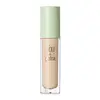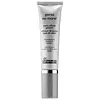Pixi Beauty Pat Away Concealing Base Cream Versus Dr. Brandt Skincare Pores No More® Pore Refiner Primer
What's inside
What's inside
 Key Ingredients
Key Ingredients

 Benefits
Benefits

 Concerns
Concerns

 Ingredients Side-by-side
Ingredients Side-by-side

Water
Skin ConditioningDimethicone
EmollientCyclopentasiloxane
EmollientDimethicone Crosspolymer
Emulsion StabilisingPhenyl Trimethicone
Skin ConditioningIsododecane
EmollientIsobutyl Methacrylate
Ethylhexyl Palmitate
EmollientQuaternium-90 Bentonite
Propylene Carbonate
SolventButylene Glycol
HumectantPolymethylsilsesquioxane
Cetyl PEG/PPG-10/1 Dimethicone
EmulsifyingHydrogenated Castor Oil
EmollientSilica
AbrasiveSorbitan Sesquioleate
EmulsifyingSodium Chloride
MaskingPhenoxyethanol
PreservativeEthylhexylglycerin
Skin ConditioningTriethylhexanoin
MaskingPolyglyceryl-4 Isostearate
EmulsifyingHexyl Laurate
EmollientLecithin
EmollientPolyhydroxystearic Acid
EmulsifyingIsopropyl Myristate
EmollientIsostearic Acid
CleansingPolyglyceryl-3 Polyricinoleate
EmulsifyingTocopheryl Acetate
AntioxidantPentaerythrityl Tetra-Di-T-Butyl Hydroxyhydrocinnamate
AntioxidantRosa Rubiginosa Seed Oil
EmollientCaprylic/Capric Triglyceride
MaskingCamellia Sinensis Leaf Extract
AntimicrobialCI 77891
Cosmetic ColorantIron Oxides
Water, Dimethicone, Cyclopentasiloxane, Dimethicone Crosspolymer, Phenyl Trimethicone, Isododecane, Isobutyl Methacrylate, Ethylhexyl Palmitate, Quaternium-90 Bentonite, Propylene Carbonate, Butylene Glycol, Polymethylsilsesquioxane, Cetyl PEG/PPG-10/1 Dimethicone, Hydrogenated Castor Oil, Silica, Sorbitan Sesquioleate, Sodium Chloride, Phenoxyethanol, Ethylhexylglycerin, Triethylhexanoin, Polyglyceryl-4 Isostearate, Hexyl Laurate, Lecithin, Polyhydroxystearic Acid, Isopropyl Myristate, Isostearic Acid, Polyglyceryl-3 Polyricinoleate, Tocopheryl Acetate, Pentaerythrityl Tetra-Di-T-Butyl Hydroxyhydrocinnamate, Rosa Rubiginosa Seed Oil, Caprylic/Capric Triglyceride, Camellia Sinensis Leaf Extract, CI 77891, Iron Oxides
Cyclopentasiloxane
EmollientWater
Skin ConditioningDimethicone Crosspolymer
Emulsion StabilisingLauryl PEG/PPG-18/18 Methicone
Skin ConditioningMethyl Methacrylate Crosspolymer
Polymethylsilsesquioxane
Dimethicone/Vinyl Dimethicone Crosspolymer
Skin ConditioningPolysilicone-11
CI 77891
Cosmetic ColorantDimethyl Isosorbide
SolventPolymethyl Methacrylate
Phenoxyethanol
PreservativePEG/PPG-18/18 Dimethicone
EmulsifyingIsopentyldiol
HumectantEthylhexyl Palmitate
EmollientCapryloyl Salicylic Acid
ExfoliatingChlorphenesin
AntimicrobialLavandula Angustifolia Oil
MaskingEthylhexylglycerin
Skin ConditioningMelaleuca Alternifolia Leaf Oil
AntioxidantSilica
AbrasiveTriethoxycaprylylsilane
Hdi/Trimethylol Hexyllactone Crosspolymer
Dimethyl Oxobenzo Dioxasilane
Skin ConditioningSilica Dimethyl Silylate
EmollientTrifolium Pratense Flower Extract
AstringentLaureth-12
EmulsifyingIron Oxides
Cyclopentasiloxane, Water, Dimethicone Crosspolymer, Lauryl PEG/PPG-18/18 Methicone, Methyl Methacrylate Crosspolymer, Polymethylsilsesquioxane, Dimethicone/Vinyl Dimethicone Crosspolymer, Polysilicone-11, CI 77891, Dimethyl Isosorbide, Polymethyl Methacrylate, Phenoxyethanol, PEG/PPG-18/18 Dimethicone, Isopentyldiol, Ethylhexyl Palmitate, Capryloyl Salicylic Acid, Chlorphenesin, Lavandula Angustifolia Oil, Ethylhexylglycerin, Melaleuca Alternifolia Leaf Oil, Silica, Triethoxycaprylylsilane, Hdi/Trimethylol Hexyllactone Crosspolymer, Dimethyl Oxobenzo Dioxasilane, Silica Dimethyl Silylate, Trifolium Pratense Flower Extract, Laureth-12, Iron Oxides
Ingredients Explained
These ingredients are found in both products.
Ingredients higher up in an ingredient list are typically present in a larger amount.
Ci 77891 is a white pigment from Titanium dioxide. It is naturally found in minerals such as rutile and ilmenite.
It's main function is to add a white color to cosmetics. It can also be mixed with other colors to create different shades.
Ci 77891 is commonly found in sunscreens due to its ability to block UV rays.
Learn more about CI 77891Cyclopentasiloxane, or D5, is a silicone used to improve texture of products and trap moisture.
D5 is considered lightweight and volatile. Volatile means it evaporates quickly after application. Once evaporated, D5 leaves a thin barrier that helps keep skin hydrated.
It is also an emollient. Emollients help soften the skin and prevent water loss. Silicones create a silky texture in products. D5 helps other ingredients become more spreadable.
Studies show D5 is safe to use in skincare products. We recommend speaking with a skincare professional if you have concerns.
Learn more about CyclopentasiloxaneDimethicone Crosspolymer is a silicone created by modifying dimethicone with hydrocarbon side chains. Due to its large size, it does not penetrate skin. It is considered non-occlusive.
Dimethicone Crosspolymer is used to stabilize and thicken products. It also helps give products a silky feel.
Ethylhexyl Palmitate, also known as octyl palmitate, is created from 2-ethylhexyl alcohol and palmitic acid. It is a fatty acid ester.
The fatty acid content of Ethylhexyl Palmitate makes it an emollient. Emollients help soften and hydrate your skin by trapping moisture within.
Ethylhexyl Palmitate is also used to help improve the texture of cosmetics. It helps other ingredient dissolve in products and help disperse ingredients more evenly.
You'll likely find this ingredient in sunscreen, as it is often used to mix UV-blocking ingredients such as avobenzone and ethylhexyl triazone.
It can also help stabilize the fragrances in a product as a fragrance fixative.
Ethylhexyl Palmitate can be used to substitute mineral oil.
Due to its high fatty acid content, it may not be fungal-acne safe.
Learn more about Ethylhexyl PalmitateEthylhexylglycerin (we can't pronounce this either) is commonly used as a preservative and skin softener. It is derived from glyceryl.
You might see Ethylhexylglycerin often paired with other preservatives such as phenoxyethanol. Ethylhexylglycerin has been found to increase the effectiveness of these other preservatives.
Phenoxyethanol is a preservative that has germicide, antimicrobial, and aromatic properties. Studies show that phenoxyethanol can prevent microbial growth. By itself, it has a scent that is similar to that of a rose.
It's often used in formulations along with Caprylyl Glycol to preserve the shelf life of products.
Polymethylsilsesquioxane is a silicone used as a film forming agent.
When applied to the skin, this ingredient creates an invisible film on the surface. This film still allows oxygen to pass through, but prevents moisture from escaping. This can help condition and hydrate the skin. It also leaves a silky feel when applied.
Polymethylsilsesquioxane has not been shown to clog pores. It has been deemed safe to use up to 55%, but most cosmetics use much less.
If you have concerns about using this ingredient, we recommend speaking with a professional.
Learn more about PolymethylsilsesquioxaneSilica, also known as silicon dioxide, is a naturally occurring mineral. It is used as a fine, spherical, and porous powder in cosmetics.
Though it has exfoliant properties, the function of silica varies depending on the product.
The unique structure of silica enhances the spreadability and adds smoothness, making it a great texture enhancer.
It is also used as an active carrier, emulsifier, and mattifier due to its ability to absorb excess oil.
In some products, tiny microneedles called spicules are made from silica or hydrolyzed sponge. When you rub them in, they lightly polish away dead skin layers and enhance the penetration of active ingredients.
Learn more about SilicaWater. It's the most common cosmetic ingredient of all. You'll usually see it at the top of ingredient lists, meaning that it makes up the largest part of the product.
So why is it so popular? Water most often acts as a solvent - this means that it helps dissolve other ingredients into the formulation.
You'll also recognize water as that liquid we all need to stay alive. If you see this, drink a glass of water. Stay hydrated!
Learn more about WaterThis ingredient is a combination of red, black, and yellow iron oxide pigments. This combination of colors is usually found in foundation, because it results in a "skin" color.